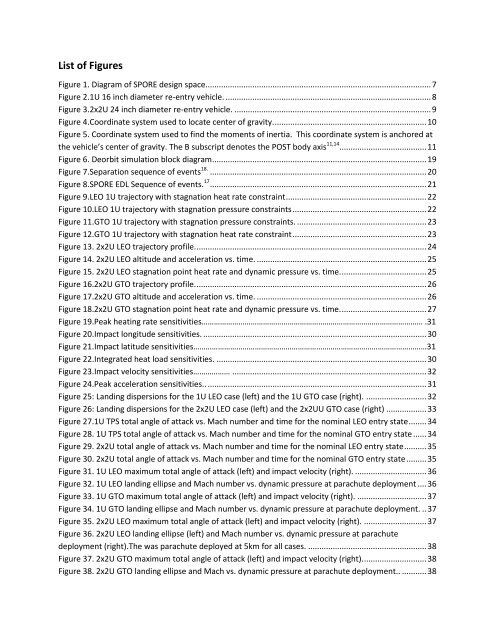SPORE Mission Design - Georgia Tech SSDL - Georgia Institute of ...
SPORE Mission Design - Georgia Tech SSDL - Georgia Institute of ...
SPORE Mission Design - Georgia Tech SSDL - Georgia Institute of ...
You also want an ePaper? Increase the reach of your titles
YUMPU automatically turns print PDFs into web optimized ePapers that Google loves.
List <strong>of</strong> Figures<br />
Figure 1. Diagram <strong>of</strong> <strong>SPORE</strong> design space ..................................................................................................... 7<br />
Figure 2.1U 16 inch diameter re-entry vehicle. ............................................................................................ 8<br />
Figure 3.2x2U 24 inch diameter re-entry vehicle. ........................................................................................ 9<br />
Figure 4.Coordinate system used to locate center <strong>of</strong> gravity. .................................................................... 10<br />
Figure 5. Coordinate system used to find the moments <strong>of</strong> inertia. This coordinate system is anchored at<br />
the vehicle’s center <strong>of</strong> gravity. The B subscript denotes the POST body axis 11,14 ....................................... 11<br />
Figure 6. Deorbit simulation block diagram ................................................................................................ 19<br />
Figure 7.Separation sequence <strong>of</strong> events 18. ................................................................................................. 20<br />
Figure 8.<strong>SPORE</strong> EDL Sequence <strong>of</strong> events. 17 ................................................................................................. 21<br />
Figure 9.LEO 1U trajectory with stagnation heat rate constraint ............................................................... 22<br />
Figure 10.LEO 1U trajectory with stagnation pressure constraints ............................................................ 22<br />
Figure 11.GTO 1U trajectory with stagnation pressure constraints. .......................................................... 23<br />
Figure 12.GTO 1U trajectory with stagnation heat rate constraint ............................................................ 23<br />
Figure 13. 2x2U LEO trajectory pr<strong>of</strong>ile. ....................................................................................................... 24<br />
Figure 14. 2x2U LEO altitude and acceleration vs. time. ............................................................................ 25<br />
Figure 15. 2x2U LEO stagnation point heat rate and dynamic pressure vs. time. ...................................... 25<br />
Figure 16.2x2U GTO trajectory pr<strong>of</strong>ile. ....................................................................................................... 26<br />
Figure 17.2x2U GTO altitude and acceleration vs. time. ............................................................................ 26<br />
Figure 18.2x2U GTO stagnation point heat rate and dynamic pressure vs. time. ...................................... 27<br />
Figure 19.Peak heating rate sensitivities……………………………………………………………………………………………… .31<br />
Figure 20.Impact longitude sensitivities. .................................................................................................... 30<br />
Figure 21.Impact latitude sensitivities……………………………………………………………………………………………………31<br />
Figure 22.Integrated heat load sensitivities. .............................................................................................. 30<br />
Figure 23.Impact velocity sensitivities……………… ....................................................................................... 32<br />
Figure 24.Peak acceleration sensitivities.. .................................................................................................. 31<br />
Figure 25: Landing dispersions for the 1U LEO case (left) and the 1U GTO case (right). ........................... 32<br />
Figure 26: Landing dispersions for the 2x2U LEO case (left) and the 2x2UU GTO case (right) .................. 33<br />
Figure 27.1U TPS total angle <strong>of</strong> attack vs. Mach number and time for the nominal LEO entry state ........ 34<br />
Figure 28. 1U TPS total angle <strong>of</strong> attack vs. Mach number and time for the nominal GTO entry state ...... 34<br />
Figure 29. 2x2U total angle <strong>of</strong> attack vs. Mach number and time for the nominal LEO entry state .......... 35<br />
Figure 30. 2x2U total angle <strong>of</strong> attack vs. Mach number and time for the nominal GTO entry state ......... 35<br />
Figure 31. 1U LEO maximum total angle <strong>of</strong> attack (left) and impact velocity (right). ................................ 36<br />
Figure 32. 1U LEO landing ellipse and Mach number vs. dynamic pressure at parachute deployment .... 36<br />
Figure 33. 1U GTO maximum total angle <strong>of</strong> attack (left) and impact velocity (right). ............................... 37<br />
Figure 34. 1U GTO landing ellipse and Mach number vs. dynamic pressure at parachute deployment. .. 37<br />
Figure 35. 2x2U LEO maximum total angle <strong>of</strong> attack (left) and impact velocity (right). ............................ 37<br />
Figure 36. 2x2U LEO landing ellipse (left) and Mach number vs. dynamic pressure at parachute<br />
deployment (right).The was parachute deployed at 5km for all cases. ..................................................... 38<br />
Figure 37. 2x2U GTO maximum total angle <strong>of</strong> attack (left) and impact velocity (right). ............................ 38<br />
Figure 38. 2x2U GTO landing ellipse and Mach vs. dynamic pressure at parachute deployment.. ........... 38
















